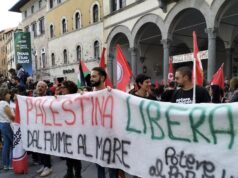Is interesting that Laurat not limited to show that the Soviet Union had established a society of exploitation and had shown the fragility of the Stalinist economic system, which at first got great success. By João Bernardo

When free expression and open organisation was allowed – before February 1922 when Lenin authorised the political police to operate within the Communist Party itself – the leftist opposition never ceased to criticise the economic system then being established. In 1920 and 1921 the Workers’ Opposition attacked the power the old management had won back in the Soviet economy and the control political organs exercised on workplace union organisation: yet this tendency was closer to the union bureaucracy than it was to the rank-and-file workers.
Within the Communist Party the rank-and-file perspective was expressed above all by the Democratic Centralist group, formed in 1919. Contrary to what one might imagine, the name of this group was not at all a reference to the Leninist form of internal party regime, bur rather the means of economic organisation. Members of this faction admitted the necessity of central planning but considered that this must be premised on democratic bases, characterised by the management of enterprises by workers’ committees: and not Lenin and Trotsky’s system of management by a technocracy of specialists, including former administrators and even the old factory owners.
But in a fascinating document distributed clandestinely in Russia in 1922 – the Appeal of the Workers’ Group – we find the first well-structured critiques of the class interests behind Bolshevism and what led it to establish a new system of capitalist exploitation.
This was a theoretical critique but also a practical one: in this case workers voting with their feet. The working class emigrated from the cities en masse and found refuge in the countryside. This migratory movement, contrary to what characterises modern societies, came in part on account of the revolution, the occupation of Ukraine and Belarus by the Central Powers and finally the civil war profoundly affecting industrial production and the growth of hunger in the cities.
“In Russia”, EH Carr wrote, “where the massive majority of the industrial working class were former peasants who generally kept certain ties to the countryside and who in some cases regularly returned there to take part in the harvest, a crisis in the cities or factories […] rather than creating unemployment as it would in western countries, instead provoked mass abandonment of the cities by industrial workers, returning to a peasant lifestyle. The disarray of industry in the first winter of the revolution had already initiated this process, and at the 7th Party Congress in March 1917 Bukharin referred to the disintegration of the proletariat. This movement was enormously accelerated when the civil war brought hundreds of thousands into the two sides’ armies, from an already reduced and exhausted population […] between 1913 and 1917 the number of salaried workers in industry fell from 3,000,000 to 2,600,000 and the fell progressively to 2,500,000 in 1918, 1,480,000 in 1920-21 and 1,240,000 in 1921-22 […] From 1917 to October 1920 the number of inhabitants of the forty provincial capitals fell by 33% […] and the number of inhabitants of fifty other large cities fell by 16% […] The larger the city, the more acute the decline. In three years, Petrograd lost 57.5% of its population, and Moscow 44.5%.
Alec Nove uses slightly different figures, 2.6 million workers in 1917 and 1.2 million in 1920, while Victor Serge, reporting on the situation in Petrograd in 1919, wrote that the population had fallen in one year from nearly 3 million to around 700,000, corresponding to a 76.7% decline in the number of inhabitants.

Apart from the economic and hunger crises, other factors weighed heavily now that the control exercised by the Bolshevik authorities was vastly greater in the cities than the countryside. The militarization of work decreed in March 1920 and Trotsky’s thinking on the alleged productivity of forced labour were hardly likely to win workers’ sympathy. In the countryside, in spite of everything, it was possible to plant something, grow enough to avoid starvation, and hide in the woods whenever this or that set of troops neared. The evacuation of the cities and the formation of semi-guerrilla, semi-rural forces – which the Bolsheviks quickly, and crudely, dubbed ‘bandits’ – was just one phenomenon resulting from this, and its development also contributed to the militarization of the workforce.
Once again Carr touched on the kernel of the problem, invoking “the paradox of the establishment of a ‘dictatorship of the proletariat’ followed by an acute diminution, both in numeric terms and in the place it occupied in the economy, of the class in whose name the dictatorship was exercised”. In reality the working class was dislodged in two ways: from above, since the managers removed the factory committees from management roles; and from below, with the depopulation of the cities and of industry.
With the end of the civil war, economic growth and repairing the social fabric were both vital. The Communist Party – not only Lenin and Trotsky, but also with the support of all the opposition factions – crushed the March 1921 insurrection of the Kronstadt sailors and the large working population of the shipyards and offices at this naval base. Following this they adopted the economic part of the programme of the insurgents, that same month inaugurating the New Economic Policy. This was a system of mixed economy, in which private companies coexisted with state intervention.
It is worth looking at how Trotsky, in the new circumstances came to see the role of the working class. In 1922, when he still held much of his former power, Trotsky proclaimed “It is necessary that each state factory, as well as its technical director and commercial director, are subject not only to control from above, that is to say by state organs, but also control from below” – from the workers? No – “that is to say by the market, which for a long period will continue to regulate the state-managed economy”. Here there was no need to mention the productivity of forced labour, since the New Economic Policy was based exclusively on wage-labour, and workers continued to be denied any leading role in the state-managed economy: it was not even the Communist Party which substituted for them in this role, but simply the market.
The freedom of initiative the New Economic Policy ceded to peasants allowed agricultural production to overcome the crisis and by 1926 to reach a level equivalent to that achieved before the beginning of World War I, while some arms of husbandry exceeded this level. Nonetheless, the stagnation of industry was not overcome and the Left Opposition feared that, if such weakness continued, the low level of industrial production would compromise the agricultural recovery itself: indeed this rapidly came to bear. Catastrophe was imminent. Thus Stalin, in one of the volte-faces of which he was a master, dropped his support for the right-wing of the Communist Party and adopted the theses of the left, launching a colossal project of social engineering.

The Five Year Plans, beginning in 1928, resolved in a very short timeframe the disastrous economic situation and ensured full employment, to such a point that the industrial working-class was insufficient and a new proletariat had to be recruited en masse. For such purposes it was necessary to centralise land ownership, making it state property, and mechanize agriculture such as to drive the excessive countryside workforce into industry. Moreover, the greatly increased exigencies of industrial production made necessary the immediate collectivisation of agriculture, liberating a workforce indispensable to industrial growth. But this was not only carried out from above. The Stalinist politburo mobilised the poorest peasants against the richer ones and even against the middle-class peasantry, unleashing what was effectively a second civil war. At the same time, with accelerated university programmes, Stalin promoted workers to the rank of engineers or technicians both quickly and en masse.
This, within a few years, permitted the liquidation in the Moscow trials of the old technocracy who had supported Zinoviev or Trotsky. Thus with three combined societal operations Stalinism created a new peasantry working on state farms, more like rural proletarians than the traditional rural population; created a new working class in a renovated and greatly enlarged industrial sector; and a new technocracy, promoted from the ranks of the proletariat. Stalin created, in sum, its own social base, and it was this much more than repression which ensured the solidity of this regime for the decades to come.
Stalinism sinking roots in domestic society corresponded to its global prestige, given that the Soviet economy reached amazing rates of growth at a time when the rest of the world was mired in a very deep crisis. To get an idea of this situation, it suffices to recall that the United States lines of qualified engineers and technicians queued outside Soviet consulates to get visas to allow them to work on the Five Year Plans. In October 1931 the Amtorg Trading Corporation, an import-export outfit which officially represented the Soviet Union to the US government until the establishment of formal diplomatic relations, received in its New York offices 100,000 requests for work.
In this context it is noteworthy that Laurat did not limit himself to showing that the Soviet Union established an exploitative society, but furthermore exposed the fragility of the Stalinist economic system, which had had first sight achieved much success.
To be continued…
Translate by The Commune. Original at http://passapalavra.info/2010/01/17055.





